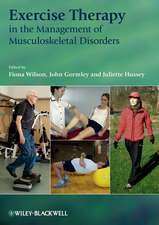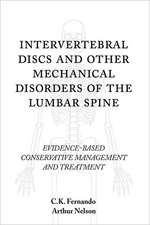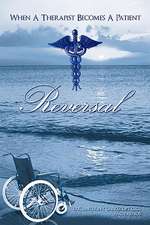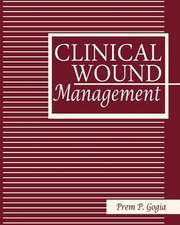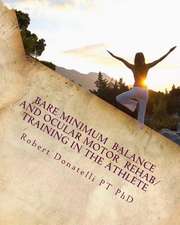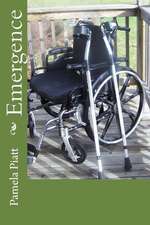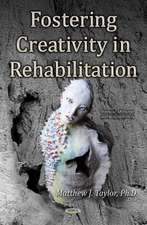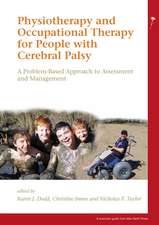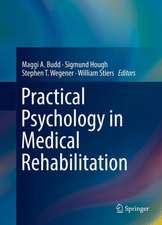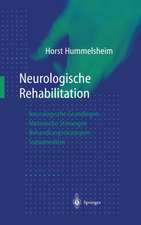Bobath Concept – Theory and Clinical Practice in Neurological Rehabilitation
Autor L Meadowsen Limba Engleză Paperback – 25 iun 2009
* covers the theoretical underpinning of the Bobath Concept / Neuro-Developmental Therapy * presents a holistic, 24-hour approach to motor learning theories * focuses on efficient movement to maximise function * forges links between theory and clinical practice * illustrated throughout.
Preț: 467.37 lei
Preț vechi: 491.97 lei
-5% Nou
89.44€ • 93.03$ • 73.84£
Carte disponibilă
Livrare economică 24 martie-07 aprilie
Livrare express 08-14 martie pentru 36.74 lei
Specificații
ISBN-10: 1405170417
Pagini: 232
Ilustrații: Illustrations
Dimensiuni: 170 x 244 x 13 mm
Greutate: 0.52 kg
Editura: Wiley
Locul publicării:Chichester, United Kingdom
Public țintă
Undergraduate and qualified physiotherapists working in neurological rehabilitation.Notă biografică
Sue Raine is Clinical Lead Physiotherapist at Walkergate Park for Neurorehabilitation and Neuropsychiatry, in Newcastle-upon-Tyne, and an experienced Bobath Tutor. Linzi Meadows is Clinical Director of the Manchester Neurotherapy Centre and Neurological Teaching Centre, as well as an Advanced Bobath Tutor. Mary Lynch-Ellerington F.C.S.P is Fellow of the Chartered Society of Physiotherapy and a Senior Bobath Instructor.
Cuprins
Foreword Prefacei Contributors Acknowledgements 1. The Bobath Concept: Developments and Current Theoretical Underpinning (Sue Raine) Introduction The founders and development of the Bobath Concept Current theory underpinning the Bobath Concept Systems approach to motor control Clinical application of the theory underpinning the Bobath Concept Summary References 2. An Understanding of Functional Movement as a Basis for Clinical Reasoning (Linzi Meadows and Jenny Williams) Introduction Normal movement versus efficient movement Compensatory strategies Motor control and motor learning Requirements of efficient movement Summary References 3. Assessment and Clinical Reasoning in the Bobath Concept (Paul Johnson) Introduction Models of clinical reasoning and the Bobath Concept Key characteristics of assessment using the Bobath Concept Basis for clinical reasoning Illustrating clinical reasoning using the Bobath Concept Summary References 4. Practice Evaluation (Helen Lindfi eld and Debbie Strang) Introduction Evaluation in the context of the International Classifi cation of Function, Disability and Health Factors influencing measurement selection Measurement properties Measures Summary References 5. Moving Between Sitting and Standing (Lynne Fletcher, Catherine Cornall and Sue Armstrong) Introduction Clinical considerations from the literature Phases of sit to stand Movements from standing to sitting Effects of ageing Sit to walk Clinical aspects Movement in functional contexts Clinical example References 6. The Control of Locomotion (Ann Holland and Mary Lynch-Ellerington) Introduction Key aspects of bipedalism The gait cycle Use of body weight support treadmill training in the Bobath Concept Assistive devices Outcome measures Summary References 7. Recovery of Upper Limb Function (Janice Champion, Chris Barber and Mary Lynch-Ellerington) Introduction The importance of postural control in upper limb function The shoulder complex Functional reach The hand Early treatment and management of the hand Assessment of the hand Contactual hand-orientating response Selective strength training of the intrinsic muscles of the hand Summary References 8. Exploring Partnerships in the Rehabilitation Setting: The 24-Hour Approach of the Bobath Concept (Clare Fraser) Partnerships in the rehabilitation environment The early days Overcoming sensory deprivation and stimulating body schema Scheduling the day - opportunities for practice Return to work Summary References Index


